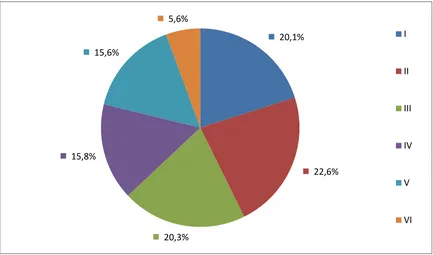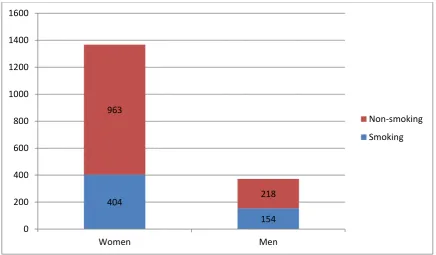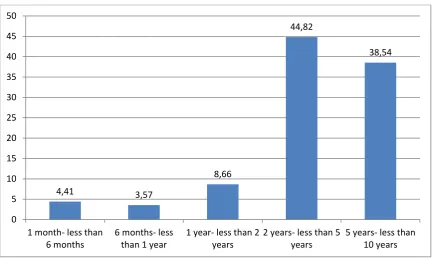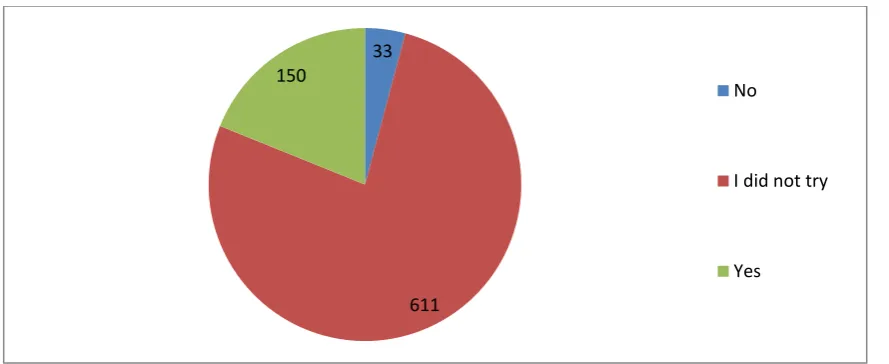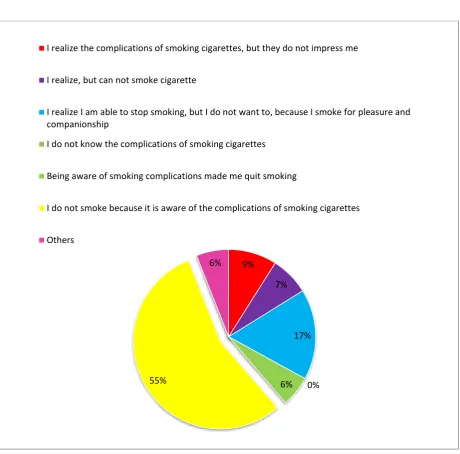189
Radzka Agnieszka, Ciechański Krystian, Tkaczyk Jędrzej, Brożyna Klaudia, Piecewicz Szczęsna Halina. Consciousness of the consequences of smoking cigarettes and the prevalence of cigarette smoking among medical students. Journal of Education, Health
and Sport. 2018;8(7):189-203. eISNN 2391-8306. DOI http://dx.doi.org/10.5281/zenodo.1299051
http://ojs.ukw.edu.pl/index.php/johs/article/view/5610
The journal has had 7 points in Ministry of Science and Higher Education parametric evaluation. Part b item 1223 (26/01/2017). 1223 Journal of Education, Health and Sport eissn 2391-8306 7
© The Authors 2018;
This article is published with open access at Licensee Open Journal Systems of Kazimierz Wielki University in Bydgoszcz, Poland
Open Access. This article is distributed under the terms of the Creative Commons Attribution Noncommercial License which permits any noncommercial use, distribution, and reproduction in any medium, provided the original author (s) and source are credited. This is an open access article licensed under the terms of the Creative Commons Attribution Non commercial license Share alike.
(http://creativecommons.org/licenses/by-nc-sa/4.0/) which permits unrestricted, non commercial use, distribution and reproduction in any medium, provided the work is properly cited.
The authors declare that there is no conflict of interests regarding the publication of this paper.
Received: 02.05.2018. Revised: 18.05.2018. Accepted: 27.06.2018.
Consciousness of the consequences of smoking cigarettes and the
prevalence of cigarette smoking among medical students
Agnieszka Radzka, Krystian Ciechański, Jędrzej Tkaczyk,
Klaudia Brożyna, Halina Piecewicz Szczęsna
Chair and Department of Epidemiology and Clinical Research Methodology, Medical University of Lublin
Address for correspondence: Agnieszka Radzka
e-mail: radzka.agnieszka@gmail.com
ORCID ID:
Agnieszka Radzka: https://orcid.org/0000-0002-3484-4602 Krystian Ciechański: https://orcid.org/0000-0003-1099-3520 Jędrzej Tkaczyk: https://orcid.org/0000-0003-2080-7525 Klaudia Brożyna: https://orcid.org/0000-0003-4313-1353
190
Abstract
Cigarettes are composed of toxic substances that result in the development of chronic obstructive pulmonary disease (COPD) and cardiovascular diseases. Smoking is also a risk factor of many cancers. Among the billions of smokers in the world, many of them are doctors and medical students - people who realize the importance of negative consequences of this addiction. We made an anonymous questionnaire, which contained 28 original questions and was published on the Internet to find out how many students of Medical Universities in Poland are addicted to tobacco and if they are aware of the consequences of their addiction.
Streszczenie
Papierosy składają się z wielu toksycznych substancji, powodują rozwój POChP, chorób
sercowo-naczyniowych, a także są predykatorami wielu nowotworów. Wśród miliardów palaczy na świecie są lekarze, studenci medycyny, ludzie, którzy zdają sobie sprawę z wagi komplikacji tego uzależnienia. Przeprowadzono anonimową ankietę, która zawierała 28 oryginalnych pytań i została opublikowana w Internecie, aby sprawdzić, ilu studentów uniwersytetów medycznych w Polsce jest uzależnionych od tytoniu i czy są oni świadomi konsekwencji uzależnienia.
Background
Cigarettes are composed of many carcinogens and toxins, especially nicotine, and are therefore a risk factor for many cancers. Cigarette smoking causes more than 480,000 deaths annually in the United States [1,2,3]. Smoking causes more deaths each year than alcohol use or illegal drugs [4]. Who published the data that says that tobacco in cigarettes kills more than 7 million people each year and more than 6 million of those deaths are the result of direct tobacco use and approximately 890,000 of those are the result of “second-hand smoke”[5]. According to the report of the Chief Sanitary Inspection in 2017, 24% of Poles are admitted to addictive (daily) smoking and men smoke more often than women (29% against 20%) [6]. Smoking causes about 90% of all lung cancer deaths [1,2]. Smoking causes about 80% of all deaths from chronic obstructive pulmonary disease (COPD) [1].
191
pancreas, kidney, uterine cervix, stomach and of acute myeloid leukemia, also as it was published in 2014 in the report of Surgeon General it causes colorectal cancer and liver cancer [8,9]. Likewise, is also associated with the risk of developing pre-cancerous lesions like colon polyps[8]. It increases the risk of men developing lung cancer by 25 timesand of women developing lung cancer by 25.7 times [1].
Cigarette smoking results in the development of chronic obstructive pulmonary disease (COPD) as well as many cardiovascular and vascular diseases, like coronary heart disease or stroke. Smokers are from 12 up to 13 times more likely to die of COPD than nonsmokers [1]. Cigarette smoking is estimated as a cause of 7.5 million prevalent cases of COPD in the United States in 2009 [10]. More than 138,000 citizens died of COPD in 2010 in the USA and it was the third main cause of death in the United States [11]. Cigarette smoking is associated with cardiovascular diseases, including coronary heart disease of which is the major cause, also including stroke and abdominal aortic aneurism [8]. Coronary heart disease and stroke are the main cause of deaths in the United States and in the high developed countries [8]. In the group of people in the age between 35 and 64 year old, more than 40 percent of all
192
world are doctors, medical students, people who realize the importance of complications of this addiction.
The aim
The aim of the survey was to show how many students of Medical Universities in Poland are addicted to tobacco. Due to the increasing popularity through youth we took the anonymous questionnaire, which contained 28 original questions and was published on the Internet.
Results
In the survey took part 1739 respondents from all Medical Universities in Poland and from different fields of study and various years of studies. 79% of respondents were women and 21% were men. 96.6% of the students who participated in the survey were aged 18-30. The frequency of respondents, depending on the year of study, was shown in Fig.1. 20.1% of participants were students of the first year of studies, 22.6% were on the second year of studies, 20.3% were on the third year of studies. Students of the upper years were smaller group of
[image:4.595.71.504.442.697.2]participants of the study. 15.8% were on the fourth year of the studies, a similar percentage of students (15.6%) were on the fifth year of the studies. The smallest group were students of the last, sixth year (5.6%).
Fig. No. 1. Prevalence of respondents by the year of study
20,1%
22,6%
20,3% 15,8%
15,6%
5,6%
I
II
III
IV
V
193 48,40% 8,90% 6,50% 4,10% 6,90% 5,90% 4,30% 4,50% 2,20% 0,30% 3,80% 2.00% 1.60% 0.40% 2.30% MEDICAL DENTISTRY PHARMACY MEDICAL ANALYST PHYSIOTHERAPY NURSING OBSTETRICS MEDICAL RESCUE PUBLIC HEALTH DENTIST TECHNIQUES DIETETICS ELECTRORADIOLOGY COSMETOLOGY BIOMEDICINE OTHERS
[image:5.595.64.521.197.457.2]Fig. 2 presents the frequency of respondents depending on the university. Most respondents of the survey were from Medical University of Lublin (16.3%). Then there were students from Medical University of Gdansk (12.5%), Medical University of Bialystok (12.4) and Medical University of Bydgoszcz (11.9%). 3% of participants chose the other answer. Despite the diversity in the frequency of responses, we were able to reach most of the medical universities in Poland.
[image:5.595.76.506.599.788.2]Fig. No. 2. Prevalence of respondents depending on the university
Fig. 3. shows the prevalence of respondents depending on the field of studies. The largest group of respondents is students of medicine (48.4%). The second largest group were dentistry students (8.90%), third place took students of physiotherapy (6.9%). We received the least responses from students of the faculties: biomedicine (0.4%) and dentist techniques (0.3%). 16% 13% 12% 12% 10% 9% 8% 7% 6% 3%1%3%
Medical University of Lublin
Medical University of Gdańsk
Medical University of Białystok
Medical University of Bydgoszcz
Medical University of Szczecin
Medical University of Warsaw
Medical University of Poznań
Medical University of Łódź
Collegium Medicum of Jagiellonian University
Medical University of Katowice
194
Fig. No. 3. Prevalence of respondents depending on the field of studies
[image:6.595.69.506.255.510.2]Fig. 4. shows the prevalence of cigarette smoking by gender. 404 (29.5%) of women said that they are smoking cigarettes, while 963 (70.5%) women said they did not smoke. 154 (41.4%) of men answered yes to the question: “Are you currently smoking cigarettes?” and the remaining 218 (58.6%) men said they did not smoke. Total of both sexes smoking participants of survey were 32.1% and not smoking were 67.9%. At the group of people, who do not smoke currently, 22.1% smoked cigarettes before.
Fig. No. 4. Prevalence of cigarette smoking by gender
Fig. 5. presents the time from which respondents smoke cigarettes. The largest group is people smoking from 2 to 5 years (44.82%, so 264 people), then 38.54% of smokers were smoking over 5 years (227 people). The smallest group where people smoking more than 6 months and less than one year (3.57 %, 62 people).
404
154 963
218
0 200 400 600 800 1000 1200 1400 1600
Women Men
Non-smoking
195
Fig. No. 5. The time from which respondents smoke cigarettes
Fig. 6. shows the stage of education on which respondents started smoking. 50.8%
[image:7.595.69.527.478.733.2]have started smoking in high school, 20.9% have started smoking during studies, mostly during first year of studies. The smallest group is people who have started smoking during 5th year of studies (0.10%). It was amazing that 2.20% of participants in the study started smoking already in elementary school and 26% in Medium School, that is, before getting of age.
Fig. No. 6. The stage of education on which respondents started smoking
4,41 3,57 8,66 44,82 38,54 0 5 10 15 20 25 30 35 40 45 50
1 month- less than 6 months
6 months- less than 1 year
1 year- less than 2 years
2 years- less than 5 years
196
43.7% (298 people) of respondents have started smoking because of increased stress. 17.8% replied that it was difficult to answer this question (309 people). To the question “Have you involved in starting smoking cigarettes because of the pressure of smoking friends?” 53.6% of respondents said “yes” and 46.4% said “no”. 66.5% of the participants replied that they were committed to start smoking with both of the above factors.
56% of participants connected the number of cigarettes smoked per day with the stress experienced during their studies. 33% of respondents did not connect it and 11% said that the question was difficult to answer. 73.1% (1272 people) said that medical studies have increased their awareness of the complications of smoking cigarettes. The amazing thing was that 26.9% (467 people) of participants responded negatively with the study of their greater awareness of addiction complications.
[image:8.595.69.514.399.581.2]99.5% of respondents as a medical student knew what the complications of addiction to cigarettes are. 76.95% of respondents have never quited smoking (611 people); 18.89% have quited smoking (150 people), while 4.16%, or 33 people, despite the attempts failed to stop smoking (Fig 7).
Fig. No. 7. The ability of smokers to quit smoking
16.8% of respondents said that they are aware of complications of smoking, but they do not want to quit it, because they like to smoke with friends and 9% of respondents said they are not afraid of that complications (Fig 8).
33
611 150
No
I did not try
197
Fig. No.8. Awareness of the harmfulness of smoking and the attitude towards smoking
Discussion
The aim of our work was to assess the prevalence of cigarette smoking and awareness of the consequences of smoking among students of medical universities in Poland. Our survey showed some important results that we would like to discuss.
Among 1739 respondents, 558 of them declared that they were currently smoking cigarettes, which accounted for 32.1% of all respondents. The percentage of smokers among medical college students is higher than this indicator in the general population. According to data of the Central Statistical Office of Poland (Główny Urząd Statystyczny), in 2009 in Poland 29.1% of the population smoked cigarettes daily or occasionally [21]. In the own study, 29.5% of women smoked cigarettes. On the other hand, this percentage in men was 41.4%. In relation to the general population, these rates are 22.8% for women, and 36.8% for men [21]. The data
9%
7%
17%
0% 6% 55%
6%
I realize the complications of smoking cigarettes, but they do not impress me
I realize, but can not smoke cigarette
I realize I am able to stop smoking, but I do not want to, because I smoke for pleasure and companionship
I do not know the complications of smoking cigarettes
Being aware of smoking complications made me quit smoking
I do not smoke because it is aware of the complications of smoking cigarettes
198
we receive is disturbing. These results testify to poor knowledge of medical students about the harmfulness of smoking. In addition, 22.1% of respondents who do not currently smoke have smoked cigarettes in the past.
With regard to other available studies on the frequency of smoking among medical college students, the percentage of smokers in our study is the highest. Kusma et al. in their study on habits and knowledge about the harmfulness of smoking among medical students in Berlin showed a percentage of smokers comparable to the general population [22]. About a quarter of the respondents were current smokers. As in our study, this percentage among men was higher and amounted to 32.4% than among women - 22.1% [22]. The Voigt et al. in their study compared the percentage of smokers among doctors and medical students to a percentage in the general population. Nonsmokers in the research group were 85.7% doctors and 78.5% students [23]. The average percentage of smokers (around 25%) turned out to be lower than in the general population in Germany (30%) and the overall European average (32%) [23]. A particularly significant difference is visible in comparison to the German population aged 18-29, which corresponds to the age group of medical students. In this population, the proportion of non-smokers was 30-45% in men and 45-55% in women and is significantly lower than in the study group [23]. This result indicates a very good awareness of the harmfulness of smoking among medical students in relation to their peer group. The study by Balogh et al. compared a group of medical students from Germany, Hungary and Norway [24]. For each group, the percentage of smokers was lower than in the compared general population of young people of a similar age from these countries. Among the students from Germany, 20% of men and 14% of women smoked cigarettes. These results were compared to the German population aged 18-24, in which the rate was 31% for men and 21% for women [24]. A higher percentage of smokers in the study was demonstrated by students from Hungary, among whom 24% of men and 16% of women smoked. However, the percentage of Hungarian population aged 18-34 was also higher, 42% men and 29% women smoked cigarettes[24]. A very low percentage of smokers among medical students from Norway was observed - 6.5% of women and 5.8% of men. Norway also has a low percentage of smokers in the population aged 16-24 - 20% in men and 14% in women [24].
199
Our study also checked at what stage of education smokers began to smoke. The largest group of people, because half of the respondents started addiction in secondary school - 50.8%. Surprisingly, the second in terms of numbers was the group of people who started to smoke at an earlier stage, as much as 26% in junior high and 2.2% in primary school. 20.9% of people in the study started smoking at university. Most often, in as many as 14.4% of cases it was in the first year of studies. In the second year, 3% of respondents started smoking, which is the second result among people starting to smoke during their studies. Such a large percentage of people starting smoking in the first year of studies may be related to the change of the environment, high load of science and stress related to it.
The largest group in our study were smokers from 2 to 5 years, it was 44.82% of all respondents. In second place in this respect, they were smokers more than 5 years old - 38.54%. This testifies to the very long duration of the addiction among the examined, because both of these groups accounted for 83.36% of all smokers.
As a reason for starting smoking, 43.7% of people indicated increasing stress. 53.6% of people admitted that the pressure of smoking friends could have a share in starting to smoke. As many as 66.5% of respondents believe that the two factors mentioned above were the factor by which they started to smoke. 55% of respondents associate the number of cigarettes smoked per day with stress related to studies. The results obtained indicate that stress-reducing courses for medical college students could be an important element in the fight against addiction. In connection with previous data, the best time to conduct such training would be the first year of study, when the most students began to smoke. Another way to reduce the level of stress among students could be to reduce the number of classes in the first year of studies and transfer them to later years.
As many as 99.5% of respondents said they knew consequences resulting from addiction to cigarettes. Interestingly, 73.1% of people felt that medical studies increased their awareness of the effects of smoking. However, as much as 26.9% commented negatively on this subject. This proves the need to carry out training among students of medical schools about the harmfulness of smoking. It is possible that such activities would have an impact on reducing the percentage of smokers among this group.
200
Conclusions
1. Approximately one third of medical students smoke cigarettes. Students are smoking
mostly because of two reasons – stress among studies and because it is the way of spending time with friends for them. 38.6% of smokers started smoking because of the stress during medical studies, 56% said they smoked more cigarettes because of college than they smoked before college.
2. Medical students are aware of the complications of smoking cigarettes. Unfortunately,
201
References
[1] U.S. Department of Health and Human Services. The Health Consequences of Smoking— 50 Years of Progress: A Report of the Surgeon General. Atlanta: U.S. Department of Health and Human Services, Centers for Disease Control and Prevention, National Center for Chronic Disease Prevention and Health Promotion, Office on Smoking and Health, 2014 [accessed 2018 April 20].
[2] U.S. Department of Health and Human Services. How Tobacco Smoke Causes Disease: What It Means to You. Atlanta: U.S. Department of Health and Human Services, Centers for Disease Control and Prevention, National Center for Chronic Disease Prevention and Health Promotion, Office on Smoking and Health, 2010 [accessed 2018 April 20].
[3] Centers for Disease Control and Prevention. QuickStats: Number of Deaths from 10 Leading Causes—National Vital Statistics System, United States, 2010. Morbidity and Mortality Weekly Report 2013:62(08);155 [accessed 2018 April 20].
[4] Mokdad AH, Marks JS, Stroup DF, Gerberding JL. Actual Causes of Death in the United States. JAMA: Journal of the American Medical Association 2004;291(10):1238–45 [accessed
2018 April 20].
[5] WHO report on the global tobacco epidemic 2017 [accessed 2018 April 20].
[6] Kantar Public „Raport z ogólnopolskiego badania ankietowego na temat postaw wobec palenia tytoniu” October 2017 [accessed 2018 April 20].
[7] ACS (American Cancer Society). Cancer facts & figures 2007. Atlanta, GA: American Cancer Society; 2007 [accessed 2018 April 20].
[8] Office of the Surgeon General (US); Office on Smoking and Health (US). The Health Consequences of Smoking: A Report of the Surgeon General. Atlanta (GA): Centers for Disease Control and Prevention (US); 2004 [accessed 2018 April 20].
[9] Committee on the Public Health Implications of Raising the Minimum Age for Purchasing Tobacco Products; Board on Population Health and Public Health Practice; Institute of Medicine; Bonnie RJ, Stratton K, Kwan LY, editors. Public Health Implications of Raising the Minimum Age of Legal Access to Tobacco Products. Washington (DC): National Academies Press (US); 2015 Jul 23 [accessed 2018 April 20].
[10] Rostron BL, Chang CM, Pechacek TF. Estimation of cigarette smoking–attributable morbidity in the United States. JAMA Internal Medicine. 2014;174(12):1922–1928.
202
[12] Yoon V, Maalouf NM, Sakhaee K. The effects of smoking on bone metabolism. Osteoporos Int. 2012 Aug;23(8):2081-92. doi: 10.1007/s00198-012-1940-y. Epub 2012 Feb 21. [13] Raju P., George R., Ramesh S Ve, Arvind H., Baskaran M,. et al. Influence of tobacco use on cataract development Br J Ophthalmol. 2006 Nov; 90(11): 1374–1377.
[14] Velilla S., García-Medina JJ., García-Layana A., Dolz-Marco R., Pons-Vázquez S.,et al., “Smoking and Age-Related Macular Degeneration: Review and Update” J Ophthalmol.
2013; 2013: 895147.
[15] Chang SA. „Smoking and Type 2 Diabetes Mellitus” Diabetes Metab J. 2012 Dec; 36(6): 399–403.
[16] Chang K, Yang SM, Kim SH, Han KH, Park SJ, Shin JI. Smoking and Rheumatoid Arthritis. Gilbert K, ed. International Journal of Molecular Sciences. 2014;15(12):22279-22295.
[17] Krall EA, Dawson-Hughes B, Garvey AJ, Garcia RI. Smoking, smoking cessation, and tooth loss. J Dent Res. 1997 Oct;76(10):1653-9.
[18] Qiu F., Liang CL., Liu H., Zeng YQ., Hou S., et al. Impacts of cigarette smoking on
immune responsiveness: Up and down or upside down? Oncotarget. 2017 Jan 3; 8(1): 268–284. [19] U.S. Department of Health and Human Services. Women and Smoking: A Report of the Surgeon General. Rockville (MD): U.S. Department of Health and Human Services, Public Health Service, Office of the Surgeon General, 2001 [accessed 2018 April 20].
[20] 2013/14 International Report: Growing up unequal: gender and socioeconomic differences in young people's health and well-being Inchley J et al. eds. Growing up unequal: gender and socioeconomic differences in young people's health and well-being. Health Behaviour in School-aged Children (HBSC) study: international report from the 2013/2014 survey.
Copenhagen, WHO Regional Office for Europe, 2016 (Health Policy for Children and Adolescents, No. 7).
[21] ”Stan zdrowia ludności Polski w 2009r.”. Główny Urząd Statystyczny [accessed 2018 June 15].
[22]Kusma B, Quarcoo D, Vitzthum K, et al. Berlin’s medical students’ smoking habits, knowledge about smoking and attitudes toward smoking cessation counseling. Journal of Occupational Medicine and Toxicology (London, England). 2010;5:9.
[23]Voigt K, Twork S, Mittag D, et al. Consumption of alcohol, cigarettes and illegal substances among physicians and medical students in Brandenburg and Saxony (Germany). BMC Health Services Research. 2009;9:219.
203
